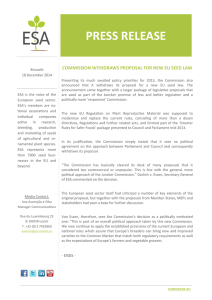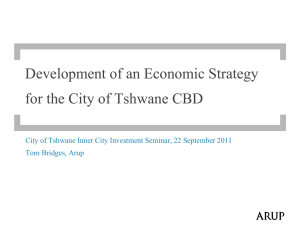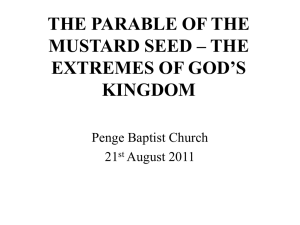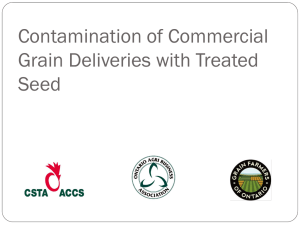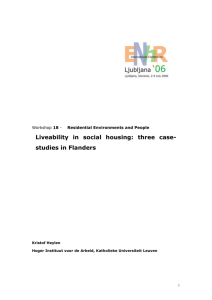Presentation /pptx - culture for sustainable development
advertisement
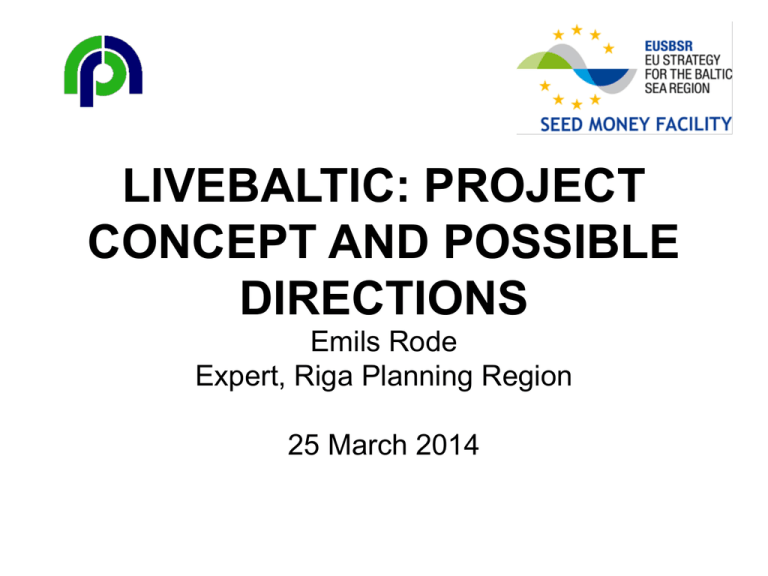
LIVEBALTIC: PROJECT CONCEPT AND POSSIBLE DIRECTIONS Emils Rode Expert, Riga Planning Region 25 March 2014 AGENDA 1. 2. 3. 4. 5. 6. Project application Liveability indexes Overview of related projects Local stakeholders Possible project focus Next steps LiveBaltic Seed Money project 2 AGENDA 1. 2. 3. 4. 5. 6. Project application Liveability indexes Overview of related projects Local stakeholders Possible project focus Next steps LiveBaltic Seed Money project 3 SEED MONEY PROJECT PARTNERSHIP Lead Partner: Uusimaa Regional Council FI Partner: Riga Planning Region LV Partner: Cleantech Estonia EE Partner: Turku Science Park FI LiveBaltic Seed Money project 4 Issue addressed and contribution to the EU Strategy for the Baltic Sea Region and EU 2020 Strategy. The issue addressed by this project is the quality of living in Baltic Sea cities. While Scandinavian capitals Copenhagen, Helsinki, Stockholm, and Oslo are ranked among the world's 'most liveable cities', other Baltic cities are far behind. Quality of living is one of the key factors for attracting international talents and increasing the competitiveness of the local economy. By sharing the knowledge and practice of planning for liveability, cities on both Western and Eastern shores of the Baltic Sea can benefit. LiveBaltic Seed Money project 5 PROJECT FOCUS (1) Quality of life or 'liveability' of a place is an important factor when international talents decide on a location to study or work. Increasing a place's reputation for quality of living directly translates into economic competitiveness. LiveBaltic Seed Money project 6 PROJECT FOCUS (2) Could other Baltic Sea cities learn from these Scandinavian champions of quality living? Many factors measured by 'liveability' indicators - such as public safety, healthcare, quality of schools, let alone climate - are beyond policy makers' reach in the short term. LiveBaltic Seed Money project 7 PROJECT FOCUS (3) However, there are ways to improve quality of life in our cities by applying smart tools from the areas of service design, social innovation, and participatory planning. (Indeed, "pro-active policy developments" is itself one of the criteria used in calculating Monocle magazine's Most Liveable Cities Index.) LiveBaltic Seed Money project 8 PROJECT FOCUS (4) The project would create a platform for discussing policy objectives, exchanging best practices and conducting pilot projects aimed at improving the quality of life indicators in Baltic Sea cities. Project stakeholders would be municipalities, government agencies, and NGOs. LiveBaltic Seed Money project 9 Work Package 1: Project management and communication Managing the project consortium and communication LiveBaltic Seed Money project 10 Work Package 2: Promoting liveable and transforming Baltic cities • Analysing best practices of city promotion to the target group of 'knowledge workers' focusing on the liveability factors. • Activities: analytical research, discussion forums, production of promotional materials. • Results: promotional materials focusing on quality of living in the city targeted at international knowledge workers. LiveBaltic Seed Money project 11 Work Package 3: Making cities for people • Analysis and application of best practices and expertise available in making the physical public spaces of cities more liveable. • Activities: workshops, training courses for municipal employees, pilot project in one of the cities. • Results: pilot project to transform the public environment implemented in one of the cities (Jūrmala). LiveBaltic Seed Money project 12 Work Package 4: Policy-making and citizen participation • Focusing on methods of involving citizens in city planning and decision making, including analysis of best practices. • Activities: workshops, training courses for municipal employees, interviews with citizens and townhall meetings, development of innovative interactive citizen participation tools. • Results: report, case study, analysis of best practice, toolbook for municipal employees. LiveBaltic Seed Money project 13 PROJECT OUTCOMES: • an established network or policy makers and planners focused on liveability issues; • a set of policy recommendations for participating cities/regions on improving planning for their liveability; • case studies of successful implementation of policies and practices aimed at improving the quality of living in cities and regions. LiveBaltic Seed Money project 14 AGENDA 1. 2. 3. 4. 5. 6. Project application Liveability indexes Overview of related projects Local stakeholders Possible project focus Next steps LiveBaltic Seed Money project 15 NORDIC CAPITALS REMAIN HIGH IN GLOBAL LIVEABILITY RANKINGS The Economist Intelligence Unit's Liveability Ranking 2013: #8 Helsinki Mercer Quality of Living Survey 2014: #9 Copenhagen Monocle magazine's Most Liveable Cities Index 2013: #1 Copenhagen, #3 Helsinki, #7 Stockholm LiveBaltic Seed Money project 16 WHAT ARE THOSE INDEXES COMPOSED OF? LiveBaltic Seed Money project 17 The Economist Intelligence Unit's Liveability Ranking and Overview This index values widespread availability of goods and services, low personal risk, and an effective infrastructure. It does not take into account the cost of living as a factor in ‘liveability’. LiveBaltic Seed Money project 18 The EIU Liveability Ranking (1) Source: The Economist Intelligence Unit LiveBaltic Seed Money project 19 The EIU Liveability Ranking (2) Source: The Economist Intelligence Unit LiveBaltic Seed Money project 20 The EIU Liveability Ranking (3) Source: The Economist Intelligence Unit LiveBaltic Seed Money project 21 Mercer Quality of Living Survey Important criteria in this index are: safety, education, hygiene, health care, culture, environment, recreation, political-economic stability, and public transportation. LiveBaltic Seed Money project 22 Monocle's Most Liveable Cities Index Important criteria in this survey are: safety/crime, international connectivity, climate/sunshine, quality of architecture, public transportation, tolerance, environmental issues and access to nature, urban design, business conditions, pro-active policy developments, and medical care. LiveBaltic Seed Money project 23 AGENDA 1. 2. 3. 4. 5. 6. Project application Liveability indexes Overview of related projects Local stakeholders Possible project focus Next steps LiveBaltic Seed Money project 24 NEW BRIDGES: Strengthening of quality of life through improved management of urban rural interaction The project aims to improve the management of the urban-rural interactions and to strengthen the quality of life within these interactions. The starting point of the project is that there are certain main elements within urban rural interactions that influence the quality of life, and thus also the attractiveness of particular region as a place to live and work in. These three elements are: Residential preferences Mobility and accessibility Provision of services Our aim in the project is, together with the residents and different stakeholders in the participating city-regions, to tackle the current challenges within these elements. The concept of quality of life and the three central elements help to bridge the gap between the individual level and the political goals to make city-region more attractive. The project will include specifically the voices of concerned individuals into the discussion among planners and other stakeholder groups and integrate their views to the development of an attractive region. http://www.urbanrural.net/ LiveBaltic Seed Money project 25 USER: Changes and conflicts in using public spaces A core USER idea is that the design of urban public spaces and the main goals of urban planning are challenged by rapid changes in how cities are used. New trends in how public spaces are used, what the new users’ needs are, increasing malfunctions and conflicts among uses, etc., are challenging the way the city is usually “produced”, designed and managed. This approach entails a process of users involvement as a crucial dimension of public spaces planning and management. Indeed “users experience” is one of the main inputs to understand how the spaces are used and what kind of conflicts are taking place. The USER project will work on the three main aspects that, according to us, constitute a "good public space": Friendlier and more interactive social-public spaces by solving malfunctions and conflicting uses, Safer public spaces in a friendlier city Cleaner, better-maintained and upgraded public spaces for a more efficient city. http://urbact.eu/en/projects/urban-renewal/user/homepage/ LiveBaltic Seed Money project 26 HerO: Heritage as Opportunity. Sustainable Management Strategies for Vital Historic Urban Landscapes The rapidly changing basic conditions of modern times pose a big challenge on the management of historic towns in Europe. The imbalance of progress and the preservation of the historic urban fabric often results in either economic stagnancy or the loss of cultural heritage values and with it the loss of identity. In this context, our network HerO aimed to develop integrated and innovative management strategies for historic urban landscapes. Our main objective was facilitating the right balance between the preservation of built cultural heritage and the sustainable, future-proof socio-economic development of historic towns in order to strengthen their attractiveness and competitiveness. Emphasis was placed on managing conflicting usage interests and capitalising the potential of cultural heritage assets for economic, social and cultural activities (Heritage as Opportunity). http://urbact.eu/en/projects/urban-renewal/hero/homepage/ LiveBaltic Seed Money project 27 WORLD DESIGN CAPITAL: SEOUL 2010 Seoul Mayor Oh Se-hoon declared, “Design is a growth driver of the Seoul economy. We have surprised the world with the Miracle of the Han River and advancements in the IT sector. Now we would like to bring global attention to Seoul with strong design.” Mayor Oh expressed high hopes for the city’s future and added, “With Seoul’s designation as World Design Capital 2010, the city will be able to breath creative energy into the design industry and reinvent itself into a globally recognised city of design and collaborate with other cities in the world to communicate with design. Seoul will send out the message that design is the power to change the world for the better.” In addition to improving quality of life, design in Seoul provides important opportunities for aligning the city’s quantitative growth with its qualitative growth and reflects on the core elements that represent the city’s intangible assets such as its identity, as well as its history. With the designation of World Design Capital 2010, Seoul is making efforts to transform itself to become a city in which its citizens are at the heart of every consideration. Such is the vision of Seoul – to create an attractive and desirable city: “Design for All”. http://www.worlddesigncapital.com/world-design-capitals/past-capital-seoul/ LiveBaltic Seed Money project 28 WORLD DESIGN CAPITAL: HELSINKI 2012 Open Helsinki – Embedding Design in Life In Helsinki, design is the enabler of building an open city, the booster of its social, economic and cultural development. This concept of Embedded Design ties design to innovation from its very beginning. Design oversees the realisation of the inhabitants’ needs and, in the final stages, ensures that the solution is desirable. This is how inventions, technologies and systems are developed into innovations suitable for everyday use. Helsinki Design is also part of world design – it is created together with the international design community and the people of the world. Helsinki Design includes well-known global brands, such as Nokia, Kone and Marimekko, popular events, like the annual Helsinki Design Week, first class education and research institutions, such as University of Art and Design Helsinki, and strong traditions, for example architects and designers Eliel Saarinen and Alvar Aalto. http://www.worlddesigncapital.com/world-design-capitals/past-capital-helsinki/ LiveBaltic Seed Money project 29 ...AND IT’S OFFSPRING: DESIGN-DRIVEN CITY HELSINKI "World Design Capital Helsinki 2012 inspired cities to review the possibilities offered by design, and the new project will help cities to apply the methods of formal design processes," says International Design Foundation board member Marco Steinberg. He explains that design can help cities to find new and often radical ways to operate and to visualise their future. International Design Foundation will hire three 'city designers', that is, professional designers who will put their design know-how to concrete uses working side by side with city staff in city development processes. The city designers will be tasked to identify areas where design can be applied and to define the ways to apply design in these areas. Among their many functions, the city designers can deepen city-staff understanding of citizen needs, and they can propose ways to encourage citizens to take more active roles in city decision making and development. As well as coaching city staff in the possibilities and practices of design, the Design Driven City project will educate the larger public sector and participate in public discussion about design. www.designdrivencity.fi www.toimivakaupunki.fi/en/ LiveBaltic Seed Money project 30 AGENDA 1. 2. 3. 4. 5. 6. Project application Liveability indexes Overview of related projects Local stakeholders Possible project focus Next steps LiveBaltic Seed Money project 31 LOCAL STAKEHOLDERS: LATVIA National government: Ministry of Regional Development and Environmental Protection State Regional Development Agency Municipalities: Riga City Council, City Development Department Riga City Architect’s Bureau Jūrmala City Council Zemgale Planning Region (partner in New Bridges project) Universities: University of Latvia, Faculty of Geography and Land Science Art Academy of Latvia, Design Department Riseba University, Faculty of Architecture and Design NGOs: Urban Institute Forum of Latvian Design / Latvian Architecture Information Centre Professionals: Latvian Association of Spatial Planners LiveBaltic Seed Money project 32 AGENDA 1. 2. 3. 4. 5. 6. Project application Liveability indexes Overview of related projects Local stakeholders Possible project focus Next steps LiveBaltic Seed Money project 33 POSSIBLE PROJECT FOCUS Themes • Citizen participation and dialogue with authorities • Data-driven management of cities / including user-generated data • Redesign of city functions involving citizens Focus • Translating liveability indicators into regional planning (one indicator, Impact possibility) • Urban planning through citizen participation (design) • Pilot/implementing concrete solutions developed by the citizens (related to smart city application) LiveBaltic Seed Money project 34 CROSS-BORDER ADDED VALUE Open for discussion: what would be the project’s added value to partners in different cities/regions of the Baltic Sea? LiveBaltic Seed Money project 35 AGENDA 1. 2. 3. 4. 5. 6. Project application Liveability indexes Overview of related projects Local stakeholders Possible project focus Next steps LiveBaltic Seed Money project 36 SUMMARY OF PROJECT PLAN Jan-June 2014 July-October 2014 Nov 2014-Feb 2015 Start-up Consolidating Submission • Partner meeting in Riga kick-off • Local stakeholder workshops in Latvia, Estonia and Finland • URC: innovation seminiar in Brussels, cooperation with EC, 18.6.2014? • Proposal writing • Partner meeting in Estonia • Partner search event in Poland or Germany? LiveBaltic Seed Money project • Proposal writing • Submission of proposal • Particpation in possible funding programme information event 37 QUESTIONS TO STAKEHOLDERS 1. What do you think of the LiveBaltic project idea/problem: is it relevant, timely, achievable? 2. What are your needs that this project could satisfy? 3. What should be this project’s focus? 4. What could we do if we had 1.5m euro today? 5. What – if any – role would you like in the future project? 6. What can we do today to advance our goals? LiveBaltic Seed Money project 38

